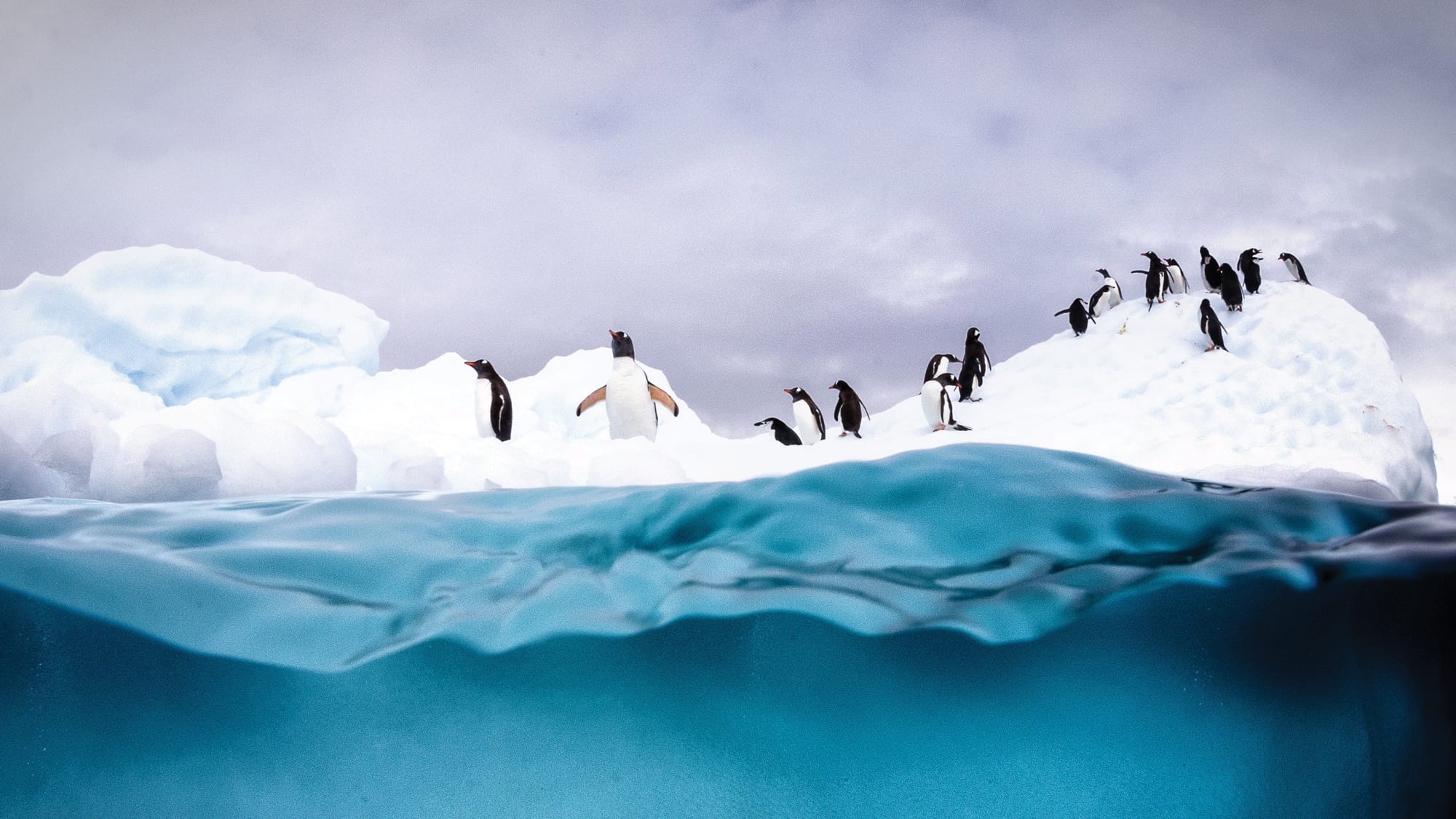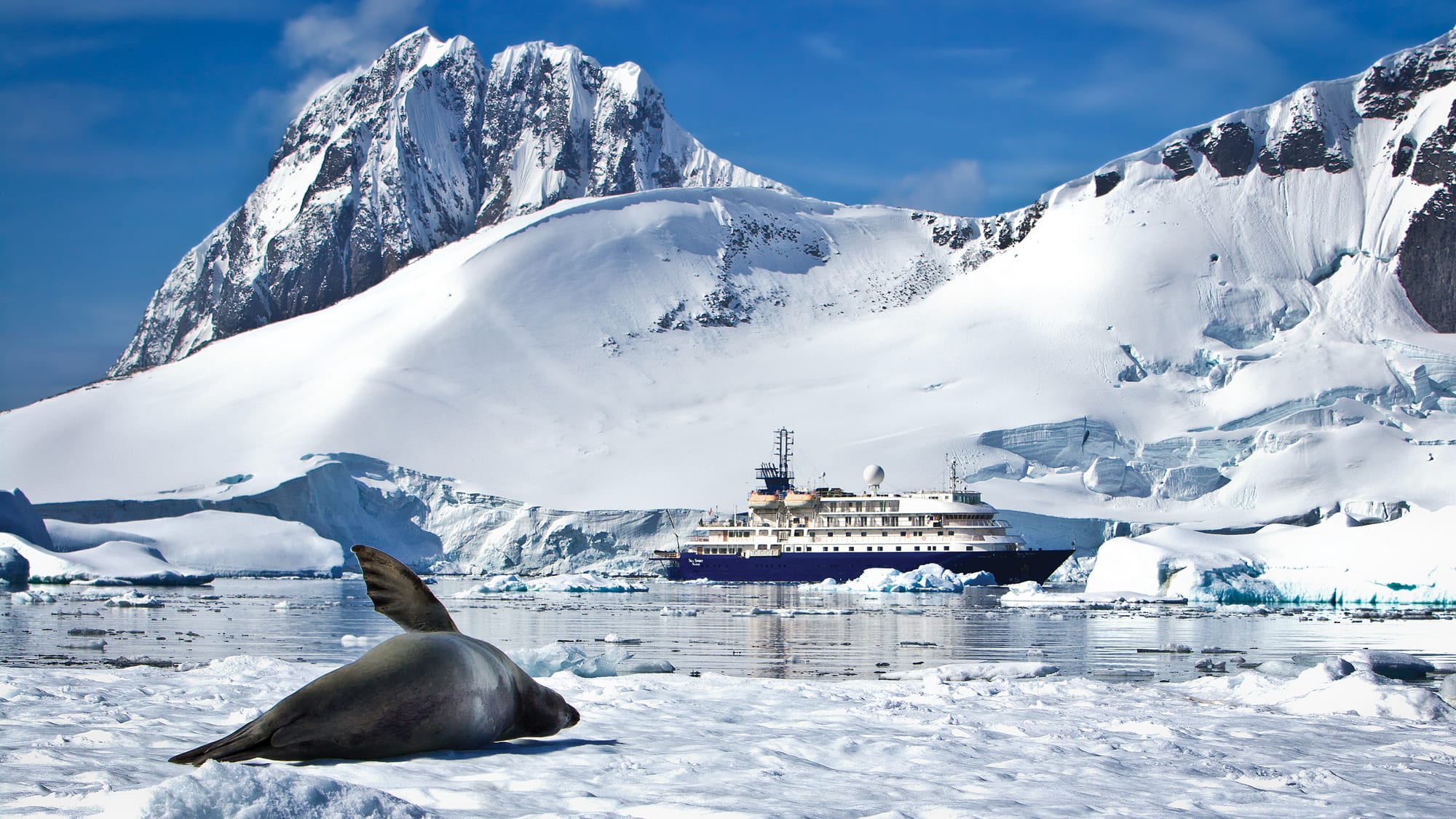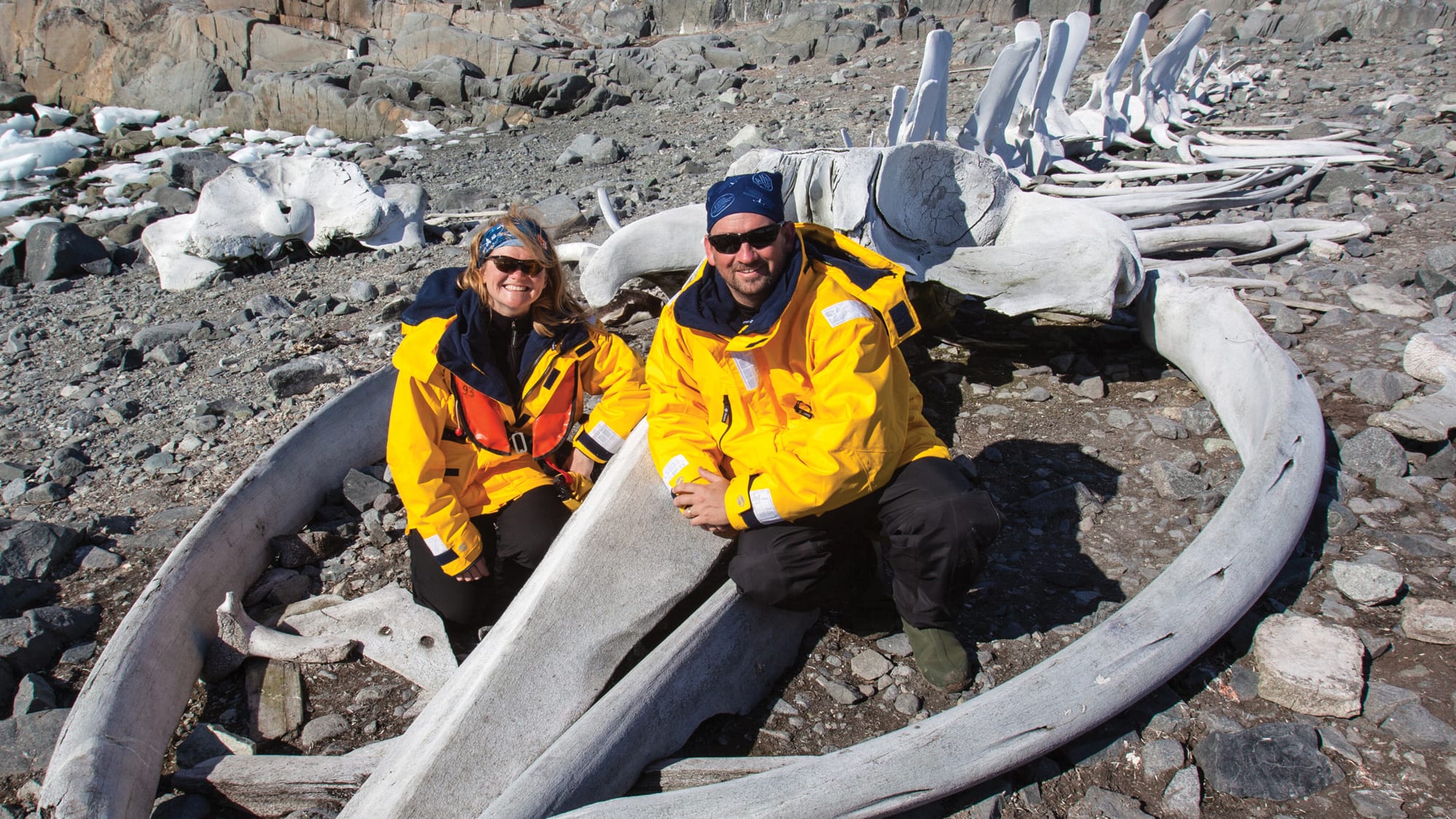Snap! Pop! The ice crackles like a bowl of crispy cereal as I kayak past a giant glacier. Penguins jump in front of the boat while seals lumber on nearby ice flows. I never thought I’d find myself surrounded by wildlife on earth’s frozen continent.
Once reserved for researchers, Antarctica is now the final frontier on many bucket lists. It’s the coldest, driest place on earth—and one of the most isolated. With more than 90 percent of its 14-million square kilometres covered in ice, it’s inhospitable to all but the hardiest creatures. Curious visitors, however, are increasingly frequenting the continent aboard small ships.
An Antarctic expedition is not only attainable for the average traveller, it can be a luxurious five-star experience: State-of-the-art yachts feature glassed-in observation decks, spas and fine dining. Quark Expeditions is one of a handful of lines catering to would-be Antarctic explorers, with a fleet of ships ranging from barebones icebreakers to lavish ocean liners. I travelled to the seventh continent with my husband, Dave, aboard Quark’s Sea Spirit, a smaller all-suite luxury ship.
As a full-time travel writer, I’ve visited 110 countries, but Antarctica proved to be our most memorable journey. And I’m not alone: “Antarctica was a humbling experience,” says Brian Miller, one of seven winners of AMA’s 7 Continents Contest in 2017.
Like us, Miller and his wife travelled on one of Quark’s luxury liners, the Ocean Diamond. “It wasn’t until the first few days of our trip that my wife, Rosina, and I realized just how lucky we are,” he adds. “Very few people get this opportunity.”

Antarctica wasn’t a trip he had ever considered, but the journey—provided by Quark Expeditions and AMA Travel and valued at $41,500—was unforgettable. An expedition trip is a unique way to see the region, giving you the chance to leave the ship and explore on land and sea. Other cruises allow you to stay on board and view the sights from the comfort of your ship.
The Millers’ adventure was one of seven prizes awarded to AMA members. Each week of the contest, an Albertan won a trip to one of the world’s seven continents. Other winners cruised the Seine in France, trekked to Peru’s Machu Picchu or toured India’s Golden Triangle.
Thanks to its close relationships with travel suppliers, AMA Travel takes members to every corner of earth. Throughout the year, members can enter contests to experience exotic locales.
WIN WITH AMA
Visit AMATravel.ca for your chance to win a once-in-a-lifetime trip and other globetrotting prizes
Most trips to Antarctica begin in Ushuaia, Argentina—among the most southerly cities in the world. During expedition season (November to March), ships depart daily from the picturesque port town, which is filled with shops, pubs and restaurants serving Patagonian craft beer and local seafood. Though isolated, Ushuaia feels cosmopolitan as tourists from around the globe congregate to pick up last-minute supplies and board their ships.
Many ships supply parkas and boots, but if you need anything else, stock up in town. Returning passengers warn us about rough going in the Drake Passage, so we buy Dramamine to stave off seasickness. It proves a fateful purchase: After leaving Ushuaia, we begin the two-day journey through very treacherous waters. Between Cape Horn and the South Shetland Islands, the Atlantic and Pacific oceans collide with awesome force. But it’s not stormy all the time: The Millers experienced a smooth journey past the islands that stretch 510 kilometres across the northern tip of Antarctica.
As we sail the Lemaire Channel—nicknamed the Kodak Gap due to its picture-perfect scenery—I expect to see a stark landscape of white and grey. Instead, I encounter an ecosystem teeming with life: whales leap out of the water; birds soar overhead; and penguins waddle along the coast.
Even the ice has personality: Calving glaciers thunder as they fall into the water; icebergs float by with layers of blue glistening in the sun. It makes me wonder about the hardships faced by the territory’s early explorers. In 1909, Norwegian navigator Roald Amundsen and British captain Robert Falcon Scott began their race to the South Pole. Amundsen landed in 1911, edging out the Brit, who arrived the following year. Tragically, Scott and his crew perished on the return journey, succumbing to exhaustion and inclement weather.
Though not the first to arrive on the continent, Sir Ernest Shackleton is the most famous of all Antarctic explorers. He sailed the icy waters three times, but disaster struck on his final voyage when ice trapped the ship, forcing captain and crew to abandon the ironically named Endurance. The group battled to survive on the ice pack until it melted months later. They eventually escaped via lifeboat.
Manoeuvering around ice packs and glaciers, I feel like an early explorer—albeit with fewer hardships and more comfort. Each day offers a new route as the captain reads the ice to find the best path forward. Dave and I join guided zodiac rides to seek out local marine life. No two rides are alike, and Quark makes sure you experience all of Antarctica up close and personal. One day, we tour the “iceberg graveyard” of Pleneau Bay. The next, we pass leopard seals napping on ice flows.

On one snowy morning, we have our most exciting encounter when a humpback whale surfaces beside our boat. Its massive eye peeks through the water, spying on our party. Awestruck, we watch as the whale dives and swims directly beneath our zodiac. Though it could easily capsize our boat, the curious creature stays just far enough away to do no harm.
The Millers likewise had a close humpback encounter. “It came out nose first and slammed into the water about 40 metres from our boat,” Brian says. They also spotted a leopard seal chasing penguins and had the rare opportunity to witness a kill: “It was nature in its most basic moment.”
Land exploration is equally insightful. On Deception Island, we visit an abandoned whaler station with gigantic whalebones littering the beach. It’s a reminder of the continent’s dark history: In the early 19th century, whales were nearly slaughtered to extinction. Though they’re now protected here, it’s a lesson about the importance of wildlife conservation.
Quark’s guides are experts in polar habitats, and help us understand the delicate balance between tourism and preservation. Expedition leader Shane Evoy shares information about chinstrap and gentoo penguins: Awkward on land but graceful in the water, they can deep dive to 200 metres and hold their breath for seven minutes. The birds are cuddly cute, but Evoy cautions us to stay at least five metres away from them—though, he adds, if you’re quiet and still, they may approach to peck at your clothes.
MORE TO READ
Everything you need to know about small-ship cruising
Aside from wildlife spotting, Antarctica bursts with extreme experiences that test your mettle. Egged on by ship staff, Dave and I decide to take the polar plunge, jumping off the stern of the ship into sub-zero waters. The frigid dip comes with bragging rights—and we’ve got the T-shirt to prove it!
Few people have stood on Antarctica. Even fewer can boast that they’ve slept there, so we jump at the chance to camp outdoors for a night. There’s nothing like falling asleep to the sound of a Weddell seal snoring just a few metres from your bivy-sack shelter.
An Antarctic expedition isn’t all adrenaline-pumping adventure. Our holiday offers a good amount of downtime too. I steal a few quiet moments for a cocktail in the lounge and a soak in the outdoor hot tub, watching ice float by. Another must-do: Send a postcard home from Antarctica’s only post office, located in the British research station.
For audacious travellers, Antarctica is the ultimate destination. But it sparks a sense of daring even in armchair adventurers. Before winning his trip through AMA, Brian Miller wouldn’t have thought of sailing Antarctic waters. The trip, however, has opened the door to more exotic expeditions: “I would definitely consider the Arctic now,” he says. You never know when opportunity—and adventure—will knock.

7 CONTINENTS CONTEST: ANTARCTICA
The 7 Continents Contest awarded exotic travel packages to all corners of the earth. Brian Miller won a once-in-a-lifetime Antarctic expedition.
Why did you enter the contest?
I bought some extra travel insurance for a trip to Cancun, so I was automatically entered. When my AMA Travel specialist, Jenny Gordon, called to tell me I’d won, I thought she was calling about a problem with my reservation!
Were you nervous about travelling to such a far-off destination?
At first I was apprehensive. I even wondered if I could exchange it for five trips to Australia! Adventure travel wasn’t my thing—I never would’ve done this on my own. But once we got on the ship, we realized how lucky we were. It’s not the kind of thing you get to do every day.
How was your on-board experience?
Quark has an excellent culinary team: The choice of meals and wine selections were different every day. I was also really impressed with the archiving of videos and photos taken during the expedition. The onboard photographer shared a picture of the day each evening, and she also created a 12-minute video of the trip. Whenever I watch it now, I choke up.
